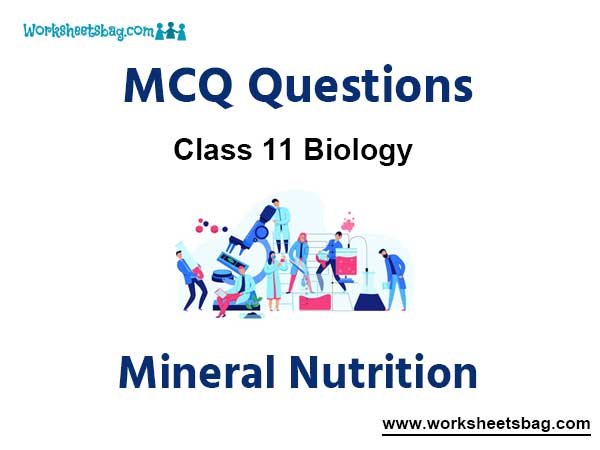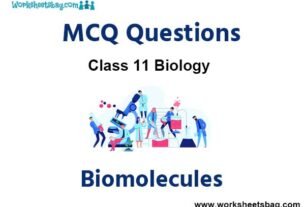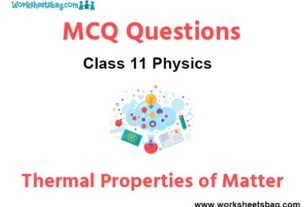Please refer to Mineral Nutrition MCQ Questions Class 11 Biology below. These MCQ questions for Class 11 Biology with answers have been designed as per the latest NCERT, CBSE books, and syllabus issued for the current academic year. These objective questions for Mineral Nutrition will help you to prepare for the exams and get more marks.
Mineral Nutrition MCQ Questions Class 11 Biology
Please see solved MCQ Questions for Mineral Nutrition in Class 11 Biology. All questions and answers have been prepared by expert faculty of standard 11 based on the latest examination guidelines.
MCQ Questions Class 11 Biology Mineral Nutrition
Question- How many of the given statements are correct?
(i) The deficiency of any element can cause multiple symptoms.
(ii) Same symptoms may be caused by the deficiency of one or several different elements.
(iii) The concentration of the essential element below which plant growth is retarded is termed as critical concentration.
(iv) Chlorosis is the loss of chlorophyll due to deficiency of N, K, Mg, Fe, S, Mn, Zn Mo.
(v) Different plants respond differently to the deficiency of the same element.
(a) (iii) and (iv)
(b) (i) and (iv)
(c) (i) and (iii)
(d) All of these
Answer
D
Question- Match column-I with column-II and choose the correct option.
Column – I Column -II
(Nutrients) (Functions)
A. Mg2+ I. Activator of dehydrogenase
B. Zn2+ II. Activator for both Ru BP carboxylaseoxygenase and PEP are
C. K+ III. Required for all Phosphorylation reactions
D. H2PO4– IV. Plays an important role in opening and closing of stomata
(a) A – II, B – IV, C – I, D – III
(b) A – II, B – I, C – IV, D – III
(c) A – III, B – I, C – IV, D – II
(d) A – III, B – I, C – II, D – IV
Answer
B
Question- Which of the following represents the abiotic mode to convert nitrogen to nitrogen oxides into the soil?
(a) Lightening
(b) Temperature
(c) Ammonification
(d) Nitrification
Answer
A
Question- The essential elements which are required by plants in large amounts are called________ and those required in very small amount by the plants are called_________.
(a) micronutrients, macronutrients
(b) bulky elements, trace elements
(c) macronutrients, micronutrients
(d) trace elements, bulky elements
Answer
C
Question- Which of the following statements about Rhizobium legume nodule formation is not correct ?
(a) Rhizobium can only fix nitrogen after it becomes a bacteroid within a root cortex cell.
(b) Rhizobium induces invagination of root hairs.
(c) Within an infection thread, Rhizobium is still extracellular to the plant.
(d) The infection thread can fuse with any root cell of an appropriate legume species.
Answer
D
Question- _________ is an constituent of the ring structure of chlorophyll and helps to maintain the ribosome structure.
(a) Manganese
(b) Magnesium
(c) Molybdenum
(d) Copper
Answer
B
Question- Which of the following statements about nitrification is not correct ?
(a) Nitrobacter oxidizes nitrite to nitrate.
(b) Nitrosomonas and Nitrosococcus convert ammonium ions to nitrite.
(c) Nitrification reactions are energy-producing (exergonic) reactions.
(d) Heterotrophic plants are more directly dependent on the nitrifying bacteria for usable nitrogen than autotrophic plants.
Answer
D
Question- Which of the following essential element is required for photochemical reaction involved in photolysis of water?
(a) Cu2+
(b) Cl –
(c) Zn2+
(d) Mg2+
Answer
B
Question- Which of the following scientist for the first time demonstrated the experiment on hydroponics?
(a) Von sachs
(b) Arnon
(c) Knop
(d) Skoog
Answer
A
Question- Which of the following elements in plants are relatively immobile and are a part of the structural component of the cell?
(a) Sulphur and calcium
(b) Sulphur and potassium
(c) Calcium and magnesium
(d) Potassium and magnesium
Answer
A
Question-More than ‘X’ elements of the ‘Y’ discovered so far are found in different plants. Identify ‘X’ and ‘Y’.
(a) X – 0; Y – 110
(b) X – 80; Y – 105
(c) X- 60; Y – 105
(d) X- 70; Y – 115
Answer
C
Question- Which of the following is not caused by deficiency of mineral nutrition?
(a) Necrosis
(b) Chlorosis
(c) Etiolation
(d) Shortening of internodes
Answer
C
Question- Hydroponics refers to the plant development
(a) without soil.
(b) in saline soil.
(c) in water without soil.
(d) without soil with alkaline pH.
Answer
C
Question- The process by which mineral is absorbed is called
(a) passive absorption
(b) active absorption
(c) both (a) and (b)
(d) none of these
Answer
C
Question- Which of the following statements are correct?
(i) Magnesium competes with iron and manganese for uptake and with iron for binding with enzymes.
(ii) Magnesium inhibit calcium translocation in shoot apex.
(iii) Excess of manganese may induce deficiencies of iron, magnesium and calcium.
(iv) Symptoms of manganese toxicity may actually be the deficiency symptoms of iron, magnesium and calcium.
(a) (i), (ii) and (iii)
(b) (i) and (ii)
(c) (iii) and (iv)
(d) (ii), (iii) and (iv)
Answer
C
Question- Conversion of N º N to NH3 occurs in plant cell by
(a) free-living bacteria
(b) symbiotic bacteria
(c) anaerobic microbes
(d) enzyme
Answer
D
Question-Which of the following element activate an enzyme, nitrogenase during nitrogen metabolism?
(a) SO42–
(b) Mg2+
(c) K+
(d) Mo
Answer
D
Question- Which of the following elements are constituents of protein?
(a) Nitrogen and phosphorus
(b) Nitrogen and chlorine
(c) Phosphorus and boron
(d) Chlorine and potassium
Answer
A
Question- Frankia produces nitrogen fixing nodules on the roots of
(a) leguminous plants
(b) n on -legumin ous plants
(c) Cycas
(d) monocot
Answer
B
Question- The amount of trace elements per kg dry matter is
(a) 10 m mole
(b) above 10 m mole
(c) less than 10 m mole
(d) 100 m mole
Answer
C
Question- The functions given below are performed by which of the following mineral ?
(i) An important constituent of proteins involved in ETS.
(ii) Activator of catalase.
(iii) Essential for chlorophyll synthesis.
(a) N
(b) Mg
(c) Fe
(d) Cd
Answer
C
Question- Which one of the following is free-living, anaerobic nitrogen-fixer ?
(a) Beijernickia
(b) Rhodospirillum
(c) Rhizobium
(d) Azotobacter
Answer
B
Question- Which of the following element is necessary in plants for protein synthesis and also it is a constituent of hormones and many of the vitamins?
(a) Calcium
(b) Phosphorus
(c) Nitrogen
(d) Magnesium
Answer
C
Question-The major role of minor elements inside living organisms is to act as
(a) binder of cell structure.
(b) co-factors of enzymes.
(c) building blocks of important amino acids.
(d) constituent of hormones.
Answer
B
Question- Match the column-I with column-II and choose the correct option.
Column-I Column-II
A. Manganese I. Component of various enzymes and participate in nitrogen metabolism.
B. Zinc II. Required for pollen germination and carbohydrate translocation
C. Molybdenum III. Helps in splitting of water to liberate oxygen during photosynthesis
D. Boron IV. Needed in the synthesis of auxin
(a) A – I, B – IV, C – III, D – IV
(b) A – III, B – II, C – I, D – IV
(c) A – III, B – IV, C – I, D – II
(d) A – IV, B – III, C – II, D – I
Answer
C
Question- Which of the following plants will enrich the soil with nitrogen?
(a) Corn
(b) Alfalfa
(c) Wheat grass
(d) Beets
Answer
B
Question- Any mineral ion concentration in tissues that reduces the dry weight of tissues by about _______ is considered toxic.
(a) 10%
(b) 20%
(c) 30%
(d) 40%
Answer
A
Question- Read the following statements (i to v) and answer the following question.
(i) Nitrogen is very essential for the sustenance of life.
(ii) N2 – fixation requires a strong reducing agent.
(iii) N2 – fixation is accomplished with the help of nitrogen fixing microbes, mainly Frankia.
(iv) The enzyme nitrogenase which plays an important role in biological N2 fixation is very sensitive to carbon dioxide.
(v) The energy, ATP, required is provided by the respiration of the host cells.
How many of the above statements are incorrect?
(a) (i), (ii) and (iii)
(b) (iii) and (v)
(c) (iii) and (iv)
(d) (ii), (iv) and (v)
Answer
C
Question- The primary amino acid from which other 17 amino acids are formed through the process of transamination is
(a) glycine
(b) aspartic acid
(c) glutamic acid
(d) arachidonic acid
Answer
C
Question- Ion transport in root occurs
(i) passively through channels.
(ii) actively through channels.
(iii) actively through carriers.
(iv) through both symplast and apoplast.
(a) (i) and (iii)
(b) (ii), (iii) and (iv)
(c) (i), (iii) and (iv)
(d) (iii) and (iv)
Answer
C
Question- Nitrogen fixation is a process of
(a) converting nitrogen in the air to form a usable form by plants.
(b) recycling nitrogen from organic matter in the soil.
(c) absorbing nitrogen from the soil.
(d) conversion of NO3 to N2 .
Answer
A
Question- The enzyme _______ which is capable of nitrogen reduction is present exclusively in prokaryotes. Such microbes are called_____.
(a) hydrogenase, N2-fixers
(b) nitrogenase, N2-fixers
(c) hydrogenase, aerobic microbes
(d) nitrogenase, aerobic microbes
Answer
B
Question- Which of the following mineral is associated with the characters/functions given below ?
(i) Helps in formation of middle lamella.
(ii) Needed in mitotic spindle formation.
(iii) Accumulates in older leaves.
(iv) Involves in normal functioning of the cell membranes.
(v) Activate certain enzymes.
(vi) Plays an important role in regulating metabolic activities.
(a) K+
(b) Fe3+
(c) NO3–
(d) Ca2+
Answer
D
Question- Denitrification is carried out by
(a) Nitrosomonas
(b) Pseudomonas
(c) Nitrobacter
(d) Nitrococcus
Answer
B
Question- Which of the following statements about nitrogen fixation is correct ?
(i) Nitrogenase is only catalytic under anaerobic conditions.
(ii) The energy for nitrogen fixation can be provided by either photosynthesis or respiration.
(iii) In nitrogen fixation, nitrogen is reduced by the addition of three successive pairs of hydrogen atoms.
(iv) Most nitrogen fixing microbes are aerobic.
(a) (i) and (ii) only
(b) (ii) and (iv) only
(c) (i), (ii) and (iii) only
(d) All of the above
Answer
B
Question- Asparagine and glutamine are the two most important
(a) amino acid
(b) amides
(c) imino acid
(d) proteins
Answer
B
Question- The nodule in a plant root where nitrogen fixing bacteria live forms from cells of the
(a) epidermis
(b) cortex
(c) endodermis
(d) vascular cylinder
Answer
B
Question- Which of the following statement(s) is/are correct?
(i) Conversion of organic nitrogen to NH4+ by soil microbes is called ammonification.
(ii) Ammonia is first oxidized to nitrite by Nitrosomonas and Nitrosococcus.
(iii) The nitrite is further oxidized to nitrate with the help of the bacterium Thiobacillus.
(iv) In leaves, nitrate is reduced to form ammonia that finally forms the –NH2 group of amino acids.
(v) Nitrosomonas, Nitrosococcus and Nitrobacter are Chemoautotrophs.
(a) (i), (ii) and (iii)
(b) (ii), (iii), (iv) and (v)
(c) (i), (iii) and (v)
(d) (i), (ii), (iv) and (v)
Answer
D
Question- Leghaemoglobin helps in
(a) transport of food in plant.
(b) nitrogen fixation.
(c) protecting nitrogenase from O2.
(d) nodule formation.
Answer
C
Question- The bond in molecular nitrogen (N2) is difficult to break, because it is a
(a) double ionic bond.
(b) quadraplex hydrogen bond.
(c) triple covalent bond.
(d) triple ionic bond.
Answer
C
Question- Which of the following statements are correct ?
(i) Solution culture/hydroponics contains all essential minerals except one, the usefulness of which is to be determined.
(ii) Na, Si, Co and selenium are beneficial element required by higher plants.
(iii) Zn is the activator of nitrogenases while Mo is the activator of alcohol dehydrogenase.
(iv) Zn is needed for auxin synthesis.
(a) (i), (ii), (iii)
(b) (i), (ii), (iv)
(c) All of these
(d) None of these
Answer
B
Question- Which of the following statement is incorrect ?
(a) Soil supplies minerals, harbours N2-fixing bacteria and other microbes, holds water, supplies O2 to root at acts as matrix that stabilises the plant.
(b) Both macro and micronutrients forms component of fertilizers and are applied as per need.
(c) Weathering and breaking down of rock enrich the soil with dissolved ions and inorganic salts.
(d) Denitrification is not done by bacteria Pseudomonas and Thiobacillus.
Answer
D
Question-Read the following statement and answer the question Infected thread carries the bacteria to the inner ‘X’ cells.
The bacteria get modified into rod-shaped bacteroids and cause inner ‘X’ and ‘Y’ cells to divide. Division and growth of ‘X’ and ‘Y’ cells lead to nodule formation.
Identify ‘X’ and ‘Y’.
(a) X-pericycle, Y – cortical
(b) X – cortical, Y – pericycle
(c) X – endodermis, Y – cortical
(d) X – epidermis, Y -pericycle
Answer
B
Question- Refer the given statements and answer the question.
(i) The element must be absolutely necessary for supporting normal growth and reproduction.
(ii) The requirement of the element must be specific and not replaceable by another element.
(iii) The element must be directly involved in the metabolism of the plant.
The above statements apply to
(a) Criteria for hydroponics
(b) Criteria for essentiality
(c) Role of micronutrients
(d) Role of macronutrients
Answer
B
Question- Pigment present in the root nodules of legume is
(a) chlorophyll-c
(b) fucoxanthin
(c) phycoerythrin
(d) leghaemoglobin
Answer
D
Question- Which of the following statements is not correct about macro- nutrients?
(a) They are present in plant tissues in excess of 100 m mole per kg of dry matter.
(b) They include C, H, O, N, P, S, K, Ca, Mg.
(c) Some elements attained from CO2 and H2O while the others are absorbed from the soil.
(d) C, H & O are mainly obtained from CO2 and H2O.
Answer
A
Question- Match the items given in column-I with their examples given in column-II and choose the correct answer.
Column-I Column-II
A. Free living aerobic I. Anabaena and Nostoc nitrogen fixers
B. Anaerobic nitrogen II. Pseudomonas and fixers Thiobacillus
C. Nitrogen fixing III. Nitrosomonas and cyanobacteria Nitrococcus
D. Denitrifying bacteria IV. Azotobacter and Beijernickia
E. Nitrifying bacteria. V. Rhodospirillum
(a) A – IV, B – V, C – I, D – II, E – III
(b) A – V, B – IV, C – I, D – III, E – II
(c) A – IV, B – V, C – II, D – III, E – I
(d) A – IV, B – III, C – I, D – II, E – V
Answer
A
Question-Boron in green plants assists in
(a) sugar transport
(b) activation of enzymes
(c) acting as enzyme cofactor
(d) photosynthesis
Answer
A
Question- Which of the following statements are incorrect ?
(i) The morphological changes are indicative of certain element deficiencies and are called deficiency symptoms.
(ii) The part of plants that show the deficiency symptoms depend on the mobility of the element in the plant.
(iii) Deficiency symptoms appear first in the young tissues whenever the element are relatively mobile.
(iv) The deficiency symptoms of Cl, Z, N, O, are visible first in the senescent leaves. Of the above statements.
(a) (iii) and (iv)
(b) (i) and (iii)
(c) (i) and (iv)
(d) (ii) and (iv)
Answer
A


